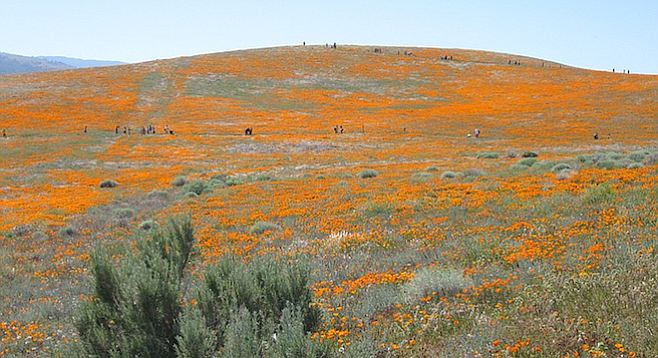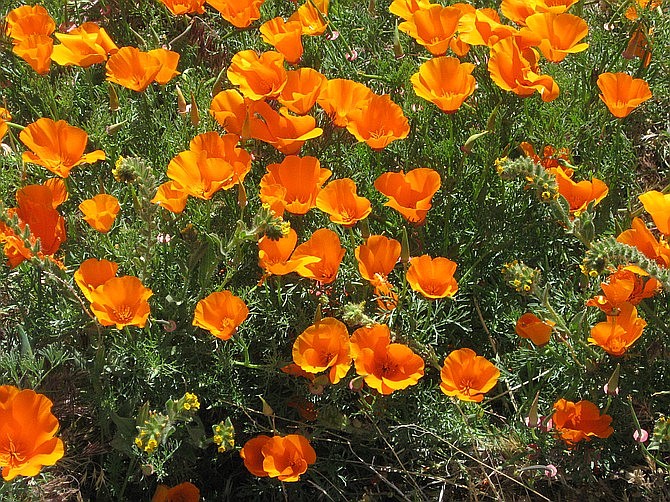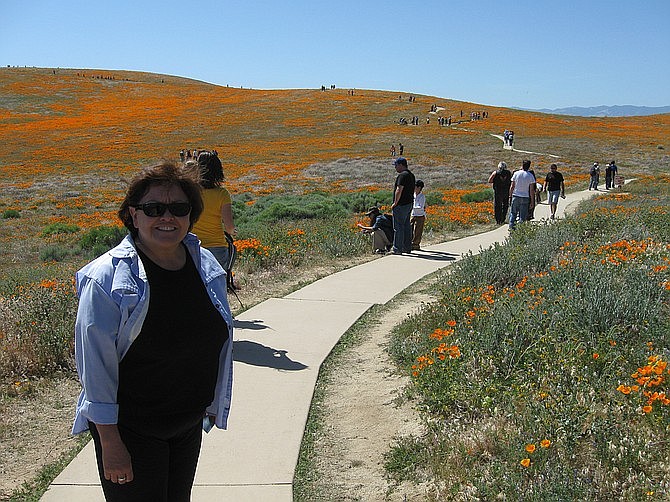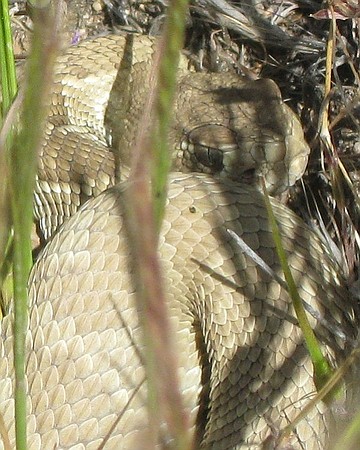 Facebook
Facebook
 X
X
 Instagram
Instagram
 TikTok
TikTok
 Youtube
Youtube

Officially known as the Antelope Valley Poppy Preserve, the rolling hills of the southern Mojave, 15 miles west of Lancaster, explode with color each spring as 1,745 acres of wildflowers end their hibernation and burst forth to seek the sun.
This poppy is our state flower, and even though it grows wild everywhere, this is the best place to find it.
Beginning in early February and lasting till late May, wander through eight miles of maintained trails surrounded by not only Mother Nature’s palette of color, but also a cornucopia of local wildlife, a leisurely hour and a half drive from Los Angeles.
Besides the poppies, you'll see Owls Clover, Lupine, Coreopsis, Cream Cups, Fiddleheads, and a couple dozen other indigenous plants I cannot begin to name. You will also probably see a bunny or two chowing down on some of these exotically named plants. This is an elevated valley that rises to 3,000 feet above sea level — so it can be quite windy even on a sunny day — but being protected land that prohibits farming or grazing, it is the most productive area for the California Poppy.

Early Spanish residents called the poppy "dormidera," or the sleepy one, as its petals curl up as if going to sleep once the sun goes down. I was also told that they fried the petals in olive oil to make a hair tonic, but won't vouch for what may be an old wives' tale.
The flower population depends entirely on the previous winter's rainfall, and to maintain the natural process of the area, the fields are not watered manually.
From the large paved parking lot, I climbed a meandering path to the Jane Pinheiro Interpretive Center, named for a local artist who spent 35 years drawing and painting the local flora and fauna and a driving force behind the creation of the current park. Some of her watercolors are on display at the center.
Inside I was treated to several dioramas of the local critters likely to pop up along the trail, especially the infamous Mojave green rattlesnake, a park native that likes to sleep close alongside the trail. (Yes, it really is green!) There's also a wonderful display of the hundreds of flower species you will encounter, and plenty of friendly volunteers to answer all your questions. Books on the area, wildlife and flora are all available at reasonable prices.
Several trails wander through the park, up and down gently sloping hills that provide panoramic views from the summits. The main trail, an easy amble from the interpretive center, takes you to Antelope Butte, the highest point in the area that's named for the Pronghorn Antelope that once roamed the valley.
There are local docents at specific points to let you know exactly what you're seeing. A state park ranger is also available. If you are lucky, you may catch a glimpse of a coyote or bobcat that frequent these fields along with hawks, meadowlarks, field mice, gophers and scorpions.
But it is the flowers that bring the visitor: the vivid orange California poppy that sways in the breeze, making you feel as though you've entered a Monet painting, as mile after mile of moving color wraps itself around you. When the wind picks up, the fields seem to sway in rhythm with it. Watching this wind make colorful waves over the hillsides gave me the feeling of being on a boat in the center of the ocean.

My wife and I meandered for over three hours, taking in spectacular views in all directions, stopping for breaks on the benches provided along the way, and taking photos that required no colors retouches or Instagram filters. Billowing white cumulous clouds in a cerulean sky provided a worthy backdrop.
Field mice scampered in and out of our feet as we walked, and more than one hawk cast its shadow over us as it patrolled the skies overhead in search of those very same mice.
The trails were packed with people of all ages, some in strollers, others in wheelchairs, and all easily negotiating the well-maintained walkways.

As warned we did run into a tiny Mojave green rattler, curled and rattling alongside the trail, but it posed no problem. A docent called the ranger, and the snake was quickly relocated unharmed, further into the foliage where it could bother no one. In fact, it was quite a treat to see one of our local predatory snakes up close in the wild.
It being late May when we visited, I was told that most of the flowers were already gone — but if that was the case, I'm going early this year. I cannot imagine there being any more flowers than we saw.
There are public restrooms and drinking fountains at the interpretive center, but visitors are advised to wear a hat, use sunblock, and carry water on the trails. Snacks are also a good idea as the nearest food is in Lancaster, 15 miles away. Wheelchairs are available if needed, but limited in number, so call ahead to reserve one. There are warning signs for the rattlesnakes along the trails, and visitors are urged not to wander off the trails into the flowers for photos. If you stay on the trail, you will be in no danger whatsoever.
Pets are not allowed on the trails unless it is a service dog, and there is no shade to leave them in the parking lot.
This poppy preserve is a perfect day trip from the big city.
How to get there: From San Diego, take interstate 5 north to highway 14 towards Mojave. In Lancaster, take the West Avenue I exit and turn left. Follow the road as it curves and you will start to see orange in the distance. Avenue I becomes Lancaster Road, so stay on it until you arrive at the center.
There's also a hotline to call during the spring months for additional information: (661) 724-1180. There is a day-use fee that may vary year to year, so call ahead. Park is open year-round from 9 a.m. to 4 p.m.


Officially known as the Antelope Valley Poppy Preserve, the rolling hills of the southern Mojave, 15 miles west of Lancaster, explode with color each spring as 1,745 acres of wildflowers end their hibernation and burst forth to seek the sun.
This poppy is our state flower, and even though it grows wild everywhere, this is the best place to find it.
Beginning in early February and lasting till late May, wander through eight miles of maintained trails surrounded by not only Mother Nature’s palette of color, but also a cornucopia of local wildlife, a leisurely hour and a half drive from Los Angeles.
Besides the poppies, you'll see Owls Clover, Lupine, Coreopsis, Cream Cups, Fiddleheads, and a couple dozen other indigenous plants I cannot begin to name. You will also probably see a bunny or two chowing down on some of these exotically named plants. This is an elevated valley that rises to 3,000 feet above sea level — so it can be quite windy even on a sunny day — but being protected land that prohibits farming or grazing, it is the most productive area for the California Poppy.

Early Spanish residents called the poppy "dormidera," or the sleepy one, as its petals curl up as if going to sleep once the sun goes down. I was also told that they fried the petals in olive oil to make a hair tonic, but won't vouch for what may be an old wives' tale.
The flower population depends entirely on the previous winter's rainfall, and to maintain the natural process of the area, the fields are not watered manually.
From the large paved parking lot, I climbed a meandering path to the Jane Pinheiro Interpretive Center, named for a local artist who spent 35 years drawing and painting the local flora and fauna and a driving force behind the creation of the current park. Some of her watercolors are on display at the center.
Inside I was treated to several dioramas of the local critters likely to pop up along the trail, especially the infamous Mojave green rattlesnake, a park native that likes to sleep close alongside the trail. (Yes, it really is green!) There's also a wonderful display of the hundreds of flower species you will encounter, and plenty of friendly volunteers to answer all your questions. Books on the area, wildlife and flora are all available at reasonable prices.
Several trails wander through the park, up and down gently sloping hills that provide panoramic views from the summits. The main trail, an easy amble from the interpretive center, takes you to Antelope Butte, the highest point in the area that's named for the Pronghorn Antelope that once roamed the valley.
There are local docents at specific points to let you know exactly what you're seeing. A state park ranger is also available. If you are lucky, you may catch a glimpse of a coyote or bobcat that frequent these fields along with hawks, meadowlarks, field mice, gophers and scorpions.
But it is the flowers that bring the visitor: the vivid orange California poppy that sways in the breeze, making you feel as though you've entered a Monet painting, as mile after mile of moving color wraps itself around you. When the wind picks up, the fields seem to sway in rhythm with it. Watching this wind make colorful waves over the hillsides gave me the feeling of being on a boat in the center of the ocean.

My wife and I meandered for over three hours, taking in spectacular views in all directions, stopping for breaks on the benches provided along the way, and taking photos that required no colors retouches or Instagram filters. Billowing white cumulous clouds in a cerulean sky provided a worthy backdrop.
Field mice scampered in and out of our feet as we walked, and more than one hawk cast its shadow over us as it patrolled the skies overhead in search of those very same mice.
The trails were packed with people of all ages, some in strollers, others in wheelchairs, and all easily negotiating the well-maintained walkways.

As warned we did run into a tiny Mojave green rattler, curled and rattling alongside the trail, but it posed no problem. A docent called the ranger, and the snake was quickly relocated unharmed, further into the foliage where it could bother no one. In fact, it was quite a treat to see one of our local predatory snakes up close in the wild.
It being late May when we visited, I was told that most of the flowers were already gone — but if that was the case, I'm going early this year. I cannot imagine there being any more flowers than we saw.
There are public restrooms and drinking fountains at the interpretive center, but visitors are advised to wear a hat, use sunblock, and carry water on the trails. Snacks are also a good idea as the nearest food is in Lancaster, 15 miles away. Wheelchairs are available if needed, but limited in number, so call ahead to reserve one. There are warning signs for the rattlesnakes along the trails, and visitors are urged not to wander off the trails into the flowers for photos. If you stay on the trail, you will be in no danger whatsoever.
Pets are not allowed on the trails unless it is a service dog, and there is no shade to leave them in the parking lot.
This poppy preserve is a perfect day trip from the big city.
How to get there: From San Diego, take interstate 5 north to highway 14 towards Mojave. In Lancaster, take the West Avenue I exit and turn left. Follow the road as it curves and you will start to see orange in the distance. Avenue I becomes Lancaster Road, so stay on it until you arrive at the center.
There's also a hotline to call during the spring months for additional information: (661) 724-1180. There is a day-use fee that may vary year to year, so call ahead. Park is open year-round from 9 a.m. to 4 p.m.
Comments